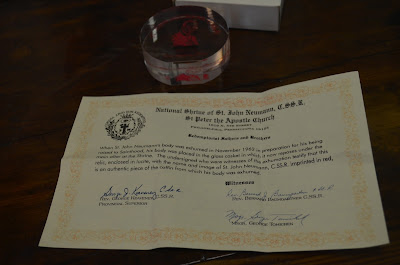INTROIT
Ps. 53:6-7
Behold, God is my helper, and the Lord is the support of my soul. Turn back the evils upon my enemies, and in Your faithfulness to us disperse them, O Lord my protector.
Ps. 53:3. O God, by Your name save me, and by Your might deliver me.
V. Glory be . . .
COLLECT - O Lord, let mercy attune Your ear to the prayers of Your people calling upon You. May they ask only what is pleasing to You, so that their requests may always be heard. Through our Lord . .
EPISTLE
I Cor. 10:6-13
Brethren: These things were done in a figure of us, that we should not covet evil things, as they also coveted. Neither become ye idolaters, as some of them, as it is written: "The people sat down to eat and drink and rose up to play." Neither let us commit fornication, as some of them that committed fornication: and there fell in one day three and twenty thousand. Neither let us tempt Christ, as some of them tempted and perished by the serpent. Neither do you murmur, as some of them murmured and were destroyed by the destroyer. Now all these things happened to them in figure: and they are written for our correction, upon whom the ends of the world are come. Wherefore, he that thinketh himself to stand, let him take heed lest he fall. Let no temptation take hold on you, but such as is human. And God is faithful, who will not suffer you to be tempted above that which you are able: but will make also with temptation issue, that you may be able to bear it.
GRADUAL
O Lord our Lord, how glorious is Your name over all the earth!
V. For Your splendor is exalted above the heavens.
Alleluia, alleluia! V. Ps. 58:2
Rescue me from my enemies, O my God, and defend me from my adversaries. Alleluia!
GOSPEL
Luke 19:41-47
At that time, when Jesus drew near to Jerusalem, seeing the city, he wept over it, saying: "If thou also hadst known, and that in this thy day, the things that are to thy peace: but now they are hidden from thy eyes. For the days shall come upon thee: and thy enemies shall cast a trench about thee and compass thee round and straiten thee on every side, And beat thee flat to the ground, and thy children who are in thee. And they shall not leave in thee a stone upon a stone: because thou hast not known the time of thy visitation." And entering into the temple, he began to cast out them that sold therein and them that bought. Saying to them: "It is written: 'My house is the house of prayer.' But you have made it a den of thieves." And he was teaching daily in the temple.
OFFERTORY
Ps. 18:9, 10, 11, 12
The precepts of the Lord are right, giving joy to the heart, and His judgments are sweeter than honey and the honeycomb; for Your servant observes them.
SECRET
May we celebrate these sacred rites worthily, O Lord, for each offering of this memorial Sacrifice carries on the work of our redemption. Through our Lord . . .
COMMUNION
John 6:57
"He who eats My flesh, and drinks My blood, abides in Me and I in him," said the Lord.
POST COMMUNION - O Lord, may the reception of Your Blessed Sacrament cleanse us from sin and unite us all in You. Through our Lord . . .
REFLECTION -
God is our Helper, and He will always come to our aid He will open the ears of His mercy to our prayers, and will not allow us to be tempted beyond our strength. Let us obey therefore with joy the precepts of the Lord; let us worthily attend In the temple the mysteries of the holy Mass, and partake of the Body of the Lord, the manna of our souls.
This day's liturgy puts before us in the Epistle and Gospel, the terrible punishments incurred by the Israelites on account of their immorality and irreligion. Twenty-three thousand Hebrews perished in one day on account of their lust; several were killed by serpents for having tempted God by complaining that they had no other food but manna ; many were killed by the destroying angel on account of their murmuring (Epistle), and over a million Jews perished when Jerusalem was destroyed for having rejected the Messiah. They were thrown out of the Kingdom of God as the sellers were driven from the temple which is its figure, for having transformed the house of prayer into a den of thieves (Gospel).
The Gentiles, called in their stead, must therefore be faithful to their vocation and take care not to fall in their turn (Epistle). Let them obey therefore with holy joy the commandments of the Lord (Offertory), let them worthily attend in the temple the Eucharistic mysteries in which the work of our redemption is daily enacted (Secret) and eat the flesh of Jesus which is the true manna of our souls (Communion).
Sources:
Saint Andrew Daily Missal and the Marian Missal , 1945





































































.jpg)




